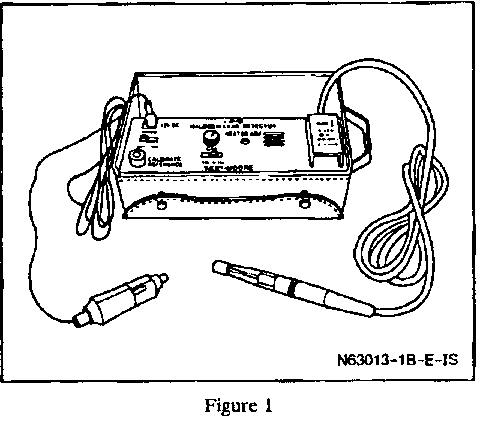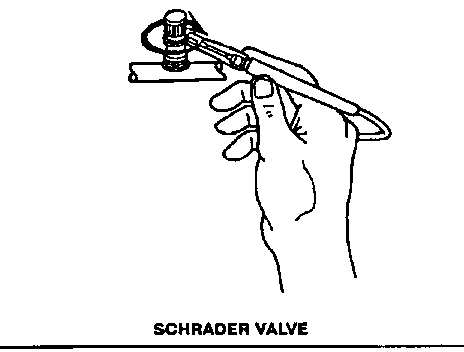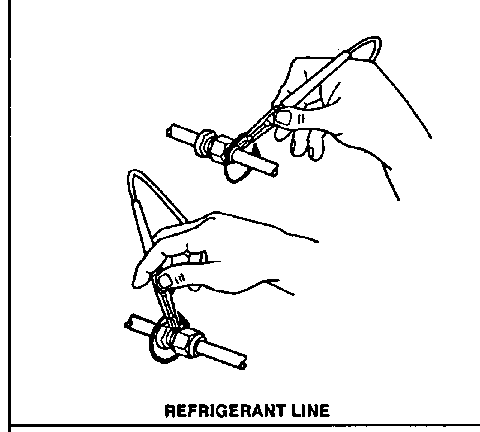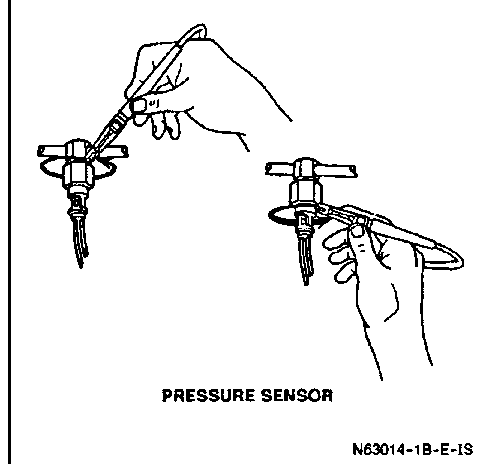A/C LEAK (DIAGNOSIS BULLETIN) ALL MODELS 1992 AND PRIOR

Subject: A/C LEAK TEST (DIAGNOSIS BULLETIN)
Models Affected: 1992 AND PRIOR YEARS - ALL MODELS
In recent years GM has focused its attention on environmental concerns, including the elimination of chlorofluorocarbons (CFC's) that are present in the refrigerant R-12. In order to optimize the ability to detect, isolate, and correct minimal standard refrigerant leaks, the Kent-Moore J-39400 Leak Detector has been made essential for all General Motors dealerships. (Revised standards permit leak rates no higher than .4 oz./year.) This tool is also capable of detecting R-134a leaks, the non CFC based refrigerant that will be used in the 1993 Firebird and later in all Pontiac models.
To assure optimal results are obtained with this tool, the procedures outlined in this bulletin must be strictly adhered to.
LEAK TESTING THE REFRIGERATION SYSTEM
A refrigerant leak test should be performed on the system whenever a leak is suspected due to system indication of low charge or after any service operation which disturbs the components, lines, or connections. Many methods and special tools are available for this purpose; however, no matter which tool is used, care and diligence are the biggest keys to success.
Electric Halogen Leak Detector Refer to Figures 1 and 2
Tool Required: J-39400 Kent-Moore Leak Detector - Essential Tool
This type of leak detector has been found to be the most useful tool in locating refrigerant leaks. The J-39400 is a small unit which operates on 12V DC and provides an audible signal which increases in frequency as R-12 or R-134a is detected. There are three settings: one for R-12, one for R-134a, and gross. The gross leak setting is for isolating very large leaks already found in one of the other two settings. Care must be taken that the instrument is properly calibrated, per the included instructions, and that the detector is used in the proper setting for the type of refrigerant system being tested.
Prior to beginning the test, make sure the refrigerant system is sufficiently charged for leak testing by measuring the static pressure with a gage set. System pressures above 50 PSIG are acceptable to conduct a leak test.
The most common leaks are found at the refrigerant fittings or connections. This may be caused by improper torque, damaged 0-rings, lack of lubricant on the 0-rings, or dirt/debris across the 0-ring. Even the smallest piece of lint from cotton gloves or shop cloths can create a leak path across an 0-ring.
The successful use of this and any other electronic leak detector depends greatly upon the scan rate and upon carefully following the manufacturer's instructions regarding calibration, operation, and maintenance. Each joint must be completely circled moving at 1-2 inches per second with the tip of the probe as close to the surface as possible but no more than 1/4" away and without blocking air intake : A leak is indicated when the audible tone goes from a steady 1-2 clicks per second to a solid alarm. The balance knob should be adjusted frequently to maintain the 1-2 clicks per second rate.
Important
o Halogen leak detectors are sensitive to windshield washing solutions, many solvents and cleaners, and some adhesives used in the vehicle. Care should be taken to prevent a false warning by making sure surfaces are clean. Also, surfaces should be dry since ingestion of liquids will damage the detector. To assure no gases are present that may cause a false warning, blow out engine compartment with air hose prior to test.
The low and high side sensors, transducers and switches, the evaporator inlet and outlet, the accumulator dryer inlet and outlet, the condenser inlet and outlet, other connections, all brazed and welded areas and areas showing signs of damage, hose couplings, and the compressor rear head and housing joints may be tested using this procedure.
Important
o Always follow the refrigerant system around in a continuous path so that no areas of potential leaks are missed. Always test all the above areas to assure the entire system is leak free, even when one leak is already found.
CAUTION:
Care should be taken to prevent personal injury which could occur due to touching a hot engine when testing. Tests should be done with the engine off and as cool as possible. Do not operate the detector in a combustible atmosphere since its sensor operates at high temperature.
Service Ports/Access Valves --------------------------- The primary seal for the service ports is the sealing cap. This cap contains a specially designed 0-ring or gasket which provides a leak-free seal. Should the cap be loose, missing, or the wrong cap used, it will result in the loss of refrigerant charge. Make sure the cap has a rubber seal.
Evaporator Core
One of the most difficult leaks to find is in the evaporator core because the core is encapsulated into a closed module and due to its inaccessibility to leak detector devices. To leak test the core:
1. Turn the blower fan on to high for 15.or more seconds then shut it off.
2. Wait 10 minutes.
3. If the blower fan power module or resistor block is accessible, remove it.
4. Insert the leak detector probe into the power module/resistor block opening. If the detector goes to a solid alarm, a leak has been found.
5. If possible, with a flashlight visually inspect the core face for evidence of refrigerant oil. Note that on R-134a systems the lubricant is water soluble so no evidence of oil is likely, even with a leak.
Compressor And Block Fitting:
1. Blow shop air behind and in front of the compressor clutch/pulley for at least 15 seconds.
2. Probe the compressor area. If the detector goes to a solid alarm, a leak has been found.
Fluorescent Leak Detector
Tool Required:
J-36790 Fluorescent Leak Detection Additive for R-12 systems only.
A leak detection additive is sometimes useful when trying to find a leak that may only become apparent with the natural vibrations and temperature/pressure relationships of a running vehicle. This type of leak detection is only practical for locating large leaks that are accessible visually under an ultraviolet light. No fluorescent detection additive is currently approved by GM for use in R-134a systems.
Liquid Leak Detectors and Pressure Testing
Due to restricted visibility in today's refrigerant systems and their lack of sensitivity, liquid/bubble leak detectors have very limited usefulness.
CAUTION:
R-134a service equipment or vehicle A/C systems should not be pressure tested or leak tested with compressed air. Some mixtures of air/R-134a have been shown to be combustible at elevated pressures. These mixtures are potentially dangerous and may result in fire or explosion causing injury or property damage. Additional health and safety information may be obtained from refrigerant and lubricant manufacturers.




General Motors bulletins are intended for use by professional technicians, not a "do-it-yourselfer". They are written to inform those technicians of conditions that may occur on some vehicles, or to provide information that could assist in the proper service of a vehicle. Properly trained technicians have the equipment, tools, safety instructions and know-how to do a job properly and safely. If a condition is described, do not assume that the bulletin applies to your vehicle, or that your vehicle will have that condition. See a General Motors dealer servicing your brand of General Motors vehicle for information on whether your vehicle may benefit from the information.
